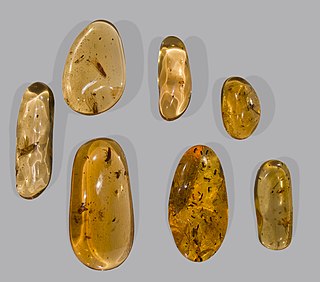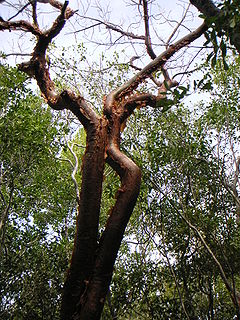
Copal is a name given to tree resin, particularly the aromatic resins from the copal tree Protium copal (Burseraceae) used by the cultures of pre-Columbian Mesoamerica as ceremonially burned incense and for other purposes. More generally, the term copal describes resinous substances in an intermediate stage of polymerization and hardening between "gummier" resins and amber.
The panacea, named after the Greek goddess of universal remedy Panacea, is any supposed remedy that is claimed to cure all diseases and prolong life indefinitely. It was in the past sought by alchemists as a connection to the elixir of life and the philosopher's stone, a mythical substance which would enable the transmutation of common metals into gold.

Alebrijes are brightly colored Mexican folk art sculptures of fantastical (fantasy/mythical) creatures. The first alebrijes, along with use of the term, originated with Pedro Linares. In the 1930s, Linares fell very ill and while he was in bed, unconscious, Linares dreamt of a strange place resembling a forest. There, he saw trees, animals, rocks, clouds that suddenly turned into something strange, some kind of animals, but, unknown animals. He saw a donkey with butterfly wings, a rooster with bull horns, a lion with an eagle head, and all of them were shouting one word, "Alebrijes". Upon recovery, he began recreating the creatures he saw in cardboard and papier-mâché and called them Alebrijes.

The Burseraceae are a moderate-sized family of 17-19 genera and about 540 species of flowering plants. The actual numbers differ according to the time period in which a given source is written describing this family. The Burseraceae are also known as the torchwood family, the frankincense and myrrh family, or simply the incense tree family. The family includes both trees and shrubs, and is native to tropical regions of Africa, Asia, and the Americas.

Bursera graveolens, known in Spanish as palo santo, is a wild tree native to Mexico and the Yucatán Peninsula to Peru and Venezuela that inhabits the South American Gran Chaco region. It is also found in Costa Rica, El Salvador, Guatemala, Honduras, Colombia, Ecuador, Peru and on the Galápagos Islands. The tree belongs to the same family (Burseraceae) as frankincense and myrrh. It is widely used in folk medicine for stomach ache, as sudorific, and as liniment for rheumatism. Aged heartwood is rich in terpenes such as limonene and α-terpineol.

The Matlacha Pass National Wildlife Refuge is part of the United States National Wildlife Refuge System, located within the Matlacha Pass estuary, approximately 8 miles northwest of Cape Coral, Florida. The 538 acre (2.2 km2) refuge was established on September 26, 1908. It is administered as part of the J.N. 'Ding' Darling National Wildlife Refuge Complex.

Bursera simaruba, commonly known as gumbo-limbo, copperwood, chaca, and turpentine tree, is a tree species in the family Burseraceae, native to tropical regions of the Americas from South Florida to Mexico and the Caribbean to Brazil, Jinotega and Venezuela. Bursera simaruba are prevalent in the Petenes mangroves ecoregion of the Yucatán, where it is a subdominant plant species to mangroves.

Protium is a genus of more than 140 species of flowering plants in the family Burseraceae. It is native to the Neotropics, Madagascar, Papua New Guinea, Indonesia and southern Asia from Pakistan east to Vietnam. The genus had been included in Bursera, but is distinct, being most closely related to Crepidospermum and Tetragastris.

Bursera microphylla is a North American species of tree in the frankincense family in the soapwood order. Bursera microphylla, known by the common name elephant tree in English or 'torote' in Spanish, is a tree in genus Bursera. It grows into a distinctive sculptural form, with a thickened, water-storing or caudiciform trunk. It is found in the southwestern United States and northwestern Mexico.
Bdallophytum is a genus of parasitic flowering plants with five described species. It parasitizes on the roots of plants of the genus Bursera, such as Bursera simaruba. The genus is endemic to the Neotropics.
The Tule Mountains is a mountain range in Yuma County, Arizona. There is a diverse flora and fauna population within the Tule Mountains; one of the notable trees found in this mountain range is the elephant tree.

Bursera fagaroides is a species of flowering plant in the genus Bursera known by the common names torchwood copal and fragrant bursera. It is widespread across much of Mexico from Sonora to Oaxaca, and its range extends just into Arizona in the United States, although some sources suggest that it may now be extirpated in Arizona.

The Waterman Mountains are a low mountainous landform in Pima County, United States. Notable among the tree species is the elephant tree which species exhibits a contorted multi-furcate architecture; most of these froze in the cold winter of 2011. The Waterman Mountain range is in the Ironwood Forest National Monument.
Copal tree may refer to several tree species:
Bursera hindsiana is a Mexican species of trees in the frankincense family in the soapwood order. It grows in Sonora and in both of the states of Baja California. This includes several of the islands in the Gulf of California.

Bursera penicillata is a Mexican species of trees in the frankincense family in the soapwood order. It is widespread in much of Mexico from Sonora and Chihuahua to Oaxaca and Veracruz.
Bursera excelsa, the copal, is a species of plants found along the Pacific coast of Mexico.










